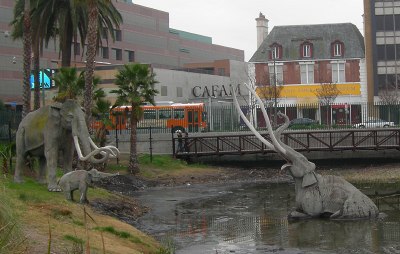February 16, 2007
A watery scene of a different sort

Music that oozes.
Continuing with the recent animal theme, we now turn to those who have become extinct, pictured above in their natural gritty urban habitat among skyscrapers and fast food: mammoths.
If I had to live outside on Wilshire Blvd. with all those cars and busses whizzing by, I’d want to become extinct, too.
One of Los Angeles’ more famous geological features, second only to our heady anthropological contribution of the Hollywood sign, The La Brea Tar Pits remind us that slick and oily creatures are not only found in agents and lawyers’ offices (rim shot, please). Long before the movie business, the real grease was here, at what is known, in its translation, as The The Tar Tar Pits.
Redundancy is omnipresent in La La Land.
I drove into the city for lunch with a colleague and found myself with something rarely possessed in Los Angeles: a little free time. Anticipating the usual amount of traffic, I had allotted myself an appropriate commute (one in which I could have flown down to Mexico) and, in a Murphy’s Law moment, arrived 30 minutes early. Not long enough to enjoy the LA County Museum of Art across the street, but certainly perfect for a contemplative look back to prehistoric time at the Page Museum’s crown jewel.
The scene around this remaining, preserved pit is R-rated: sad, terrifying and depressing. Father and child stand helplessly on the shore as mom is irreversibly mired in gooey asphalt seeping from below. My mood was only darkened by the sight of what the area had become tens of thousands of years later, at the hands of a species with its own asphalt abuse problems. I was relieved to turn away after a few minutes and walk over to the restaurant. In the desperate faces of those mammoths, I saw all of us.
 …listen
…listen …info about the music
…info about the music



